Business Environment: Types, Structure, and Objectives Report
VerifiedAdded on 2020/07/22
|13
|3329
|35
Report
AI Summary
This report provides a detailed analysis of the business environment, focusing on different types of organizations such as private, public, voluntary, legal, and partnerships, using NATWEST as a case study. It explores the size and scope of these organizations, highlighting their advantages and disadvantages. The report further examines the relationship between various departments like finance, marketing, human resources, and transportation, and how they link with organizational objectives and structure. It includes an analysis of functional and divisional organizational structures, along with the use of organization charts to illustrate lines of authority and departmental interrelationships. The report also references the organizational structure of the Royal Bank of Scotland Group PLC and its subsidiary, NatWest, and provides examples from Tesco to illustrate the practical application of different organizational structures.
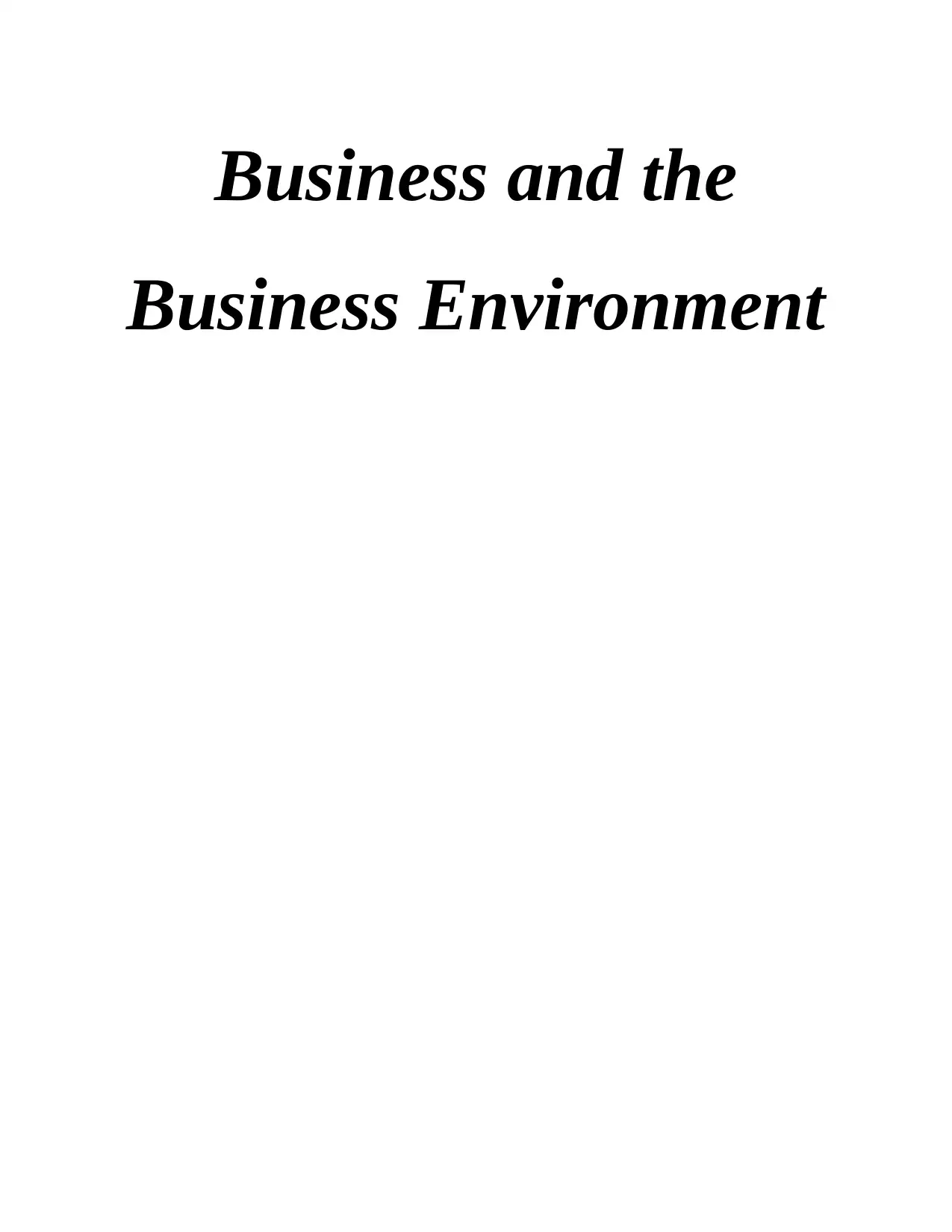
Business and the
Business Environment
Business Environment
Paraphrase This Document
Need a fresh take? Get an instant paraphrase of this document with our AI Paraphraser
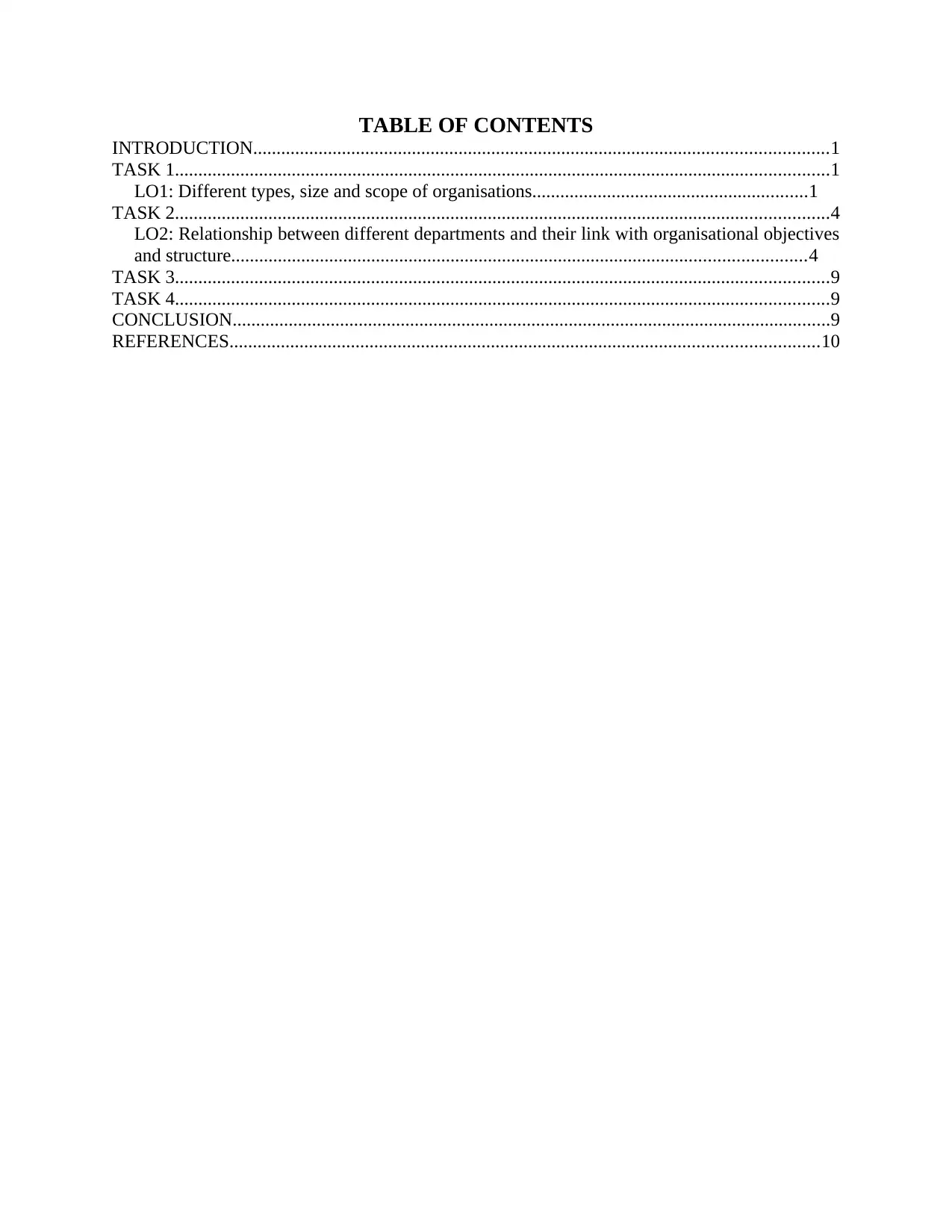
TABLE OF CONTENTS
INTRODUCTION...........................................................................................................................1
TASK 1............................................................................................................................................1
LO1: Different types, size and scope of organisations...........................................................1
TASK 2............................................................................................................................................4
LO2: Relationship between different departments and their link with organisational objectives
and structure...........................................................................................................................4
TASK 3............................................................................................................................................9
TASK 4............................................................................................................................................9
CONCLUSION................................................................................................................................9
REFERENCES..............................................................................................................................10
INTRODUCTION...........................................................................................................................1
TASK 1............................................................................................................................................1
LO1: Different types, size and scope of organisations...........................................................1
TASK 2............................................................................................................................................4
LO2: Relationship between different departments and their link with organisational objectives
and structure...........................................................................................................................4
TASK 3............................................................................................................................................9
TASK 4............................................................................................................................................9
CONCLUSION................................................................................................................................9
REFERENCES..............................................................................................................................10
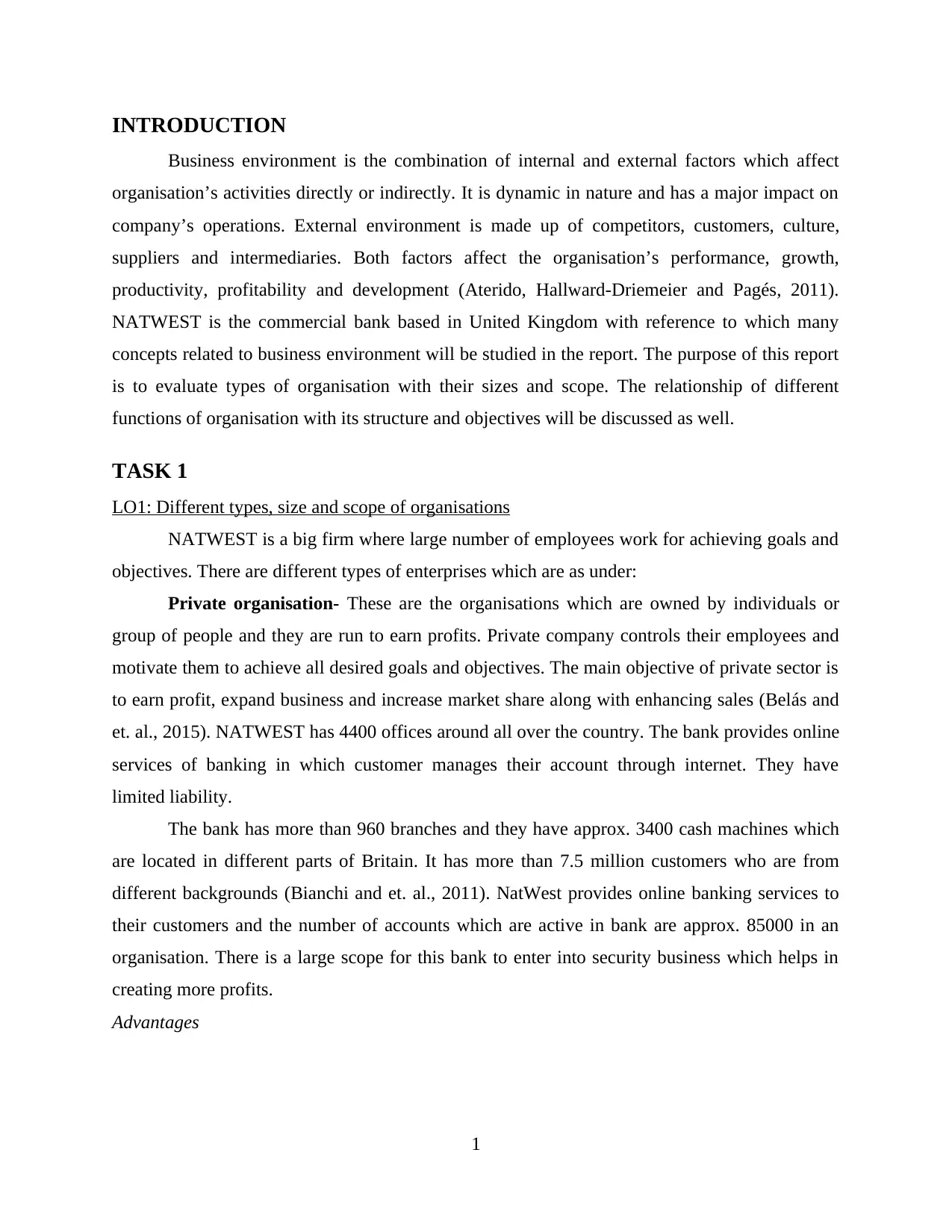
INTRODUCTION
Business environment is the combination of internal and external factors which affect
organisation’s activities directly or indirectly. It is dynamic in nature and has a major impact on
company’s operations. External environment is made up of competitors, customers, culture,
suppliers and intermediaries. Both factors affect the organisation’s performance, growth,
productivity, profitability and development (Aterido, Hallward-Driemeier and Pagés, 2011).
NATWEST is the commercial bank based in United Kingdom with reference to which many
concepts related to business environment will be studied in the report. The purpose of this report
is to evaluate types of organisation with their sizes and scope. The relationship of different
functions of organisation with its structure and objectives will be discussed as well.
TASK 1
LO1: Different types, size and scope of organisations
NATWEST is a big firm where large number of employees work for achieving goals and
objectives. There are different types of enterprises which are as under:
Private organisation- These are the organisations which are owned by individuals or
group of people and they are run to earn profits. Private company controls their employees and
motivate them to achieve all desired goals and objectives. The main objective of private sector is
to earn profit, expand business and increase market share along with enhancing sales (Belás and
et. al., 2015). NATWEST has 4400 offices around all over the country. The bank provides online
services of banking in which customer manages their account through internet. They have
limited liability.
The bank has more than 960 branches and they have approx. 3400 cash machines which
are located in different parts of Britain. It has more than 7.5 million customers who are from
different backgrounds (Bianchi and et. al., 2011). NatWest provides online banking services to
their customers and the number of accounts which are active in bank are approx. 85000 in an
organisation. There is a large scope for this bank to enter into security business which helps in
creating more profits.
Advantages
1
Business environment is the combination of internal and external factors which affect
organisation’s activities directly or indirectly. It is dynamic in nature and has a major impact on
company’s operations. External environment is made up of competitors, customers, culture,
suppliers and intermediaries. Both factors affect the organisation’s performance, growth,
productivity, profitability and development (Aterido, Hallward-Driemeier and Pagés, 2011).
NATWEST is the commercial bank based in United Kingdom with reference to which many
concepts related to business environment will be studied in the report. The purpose of this report
is to evaluate types of organisation with their sizes and scope. The relationship of different
functions of organisation with its structure and objectives will be discussed as well.
TASK 1
LO1: Different types, size and scope of organisations
NATWEST is a big firm where large number of employees work for achieving goals and
objectives. There are different types of enterprises which are as under:
Private organisation- These are the organisations which are owned by individuals or
group of people and they are run to earn profits. Private company controls their employees and
motivate them to achieve all desired goals and objectives. The main objective of private sector is
to earn profit, expand business and increase market share along with enhancing sales (Belás and
et. al., 2015). NATWEST has 4400 offices around all over the country. The bank provides online
services of banking in which customer manages their account through internet. They have
limited liability.
The bank has more than 960 branches and they have approx. 3400 cash machines which
are located in different parts of Britain. It has more than 7.5 million customers who are from
different backgrounds (Bianchi and et. al., 2011). NatWest provides online banking services to
their customers and the number of accounts which are active in bank are approx. 85000 in an
organisation. There is a large scope for this bank to enter into security business which helps in
creating more profits.
Advantages
1
⊘ This is a preview!⊘
Do you want full access?
Subscribe today to unlock all pages.

Trusted by 1+ million students worldwide
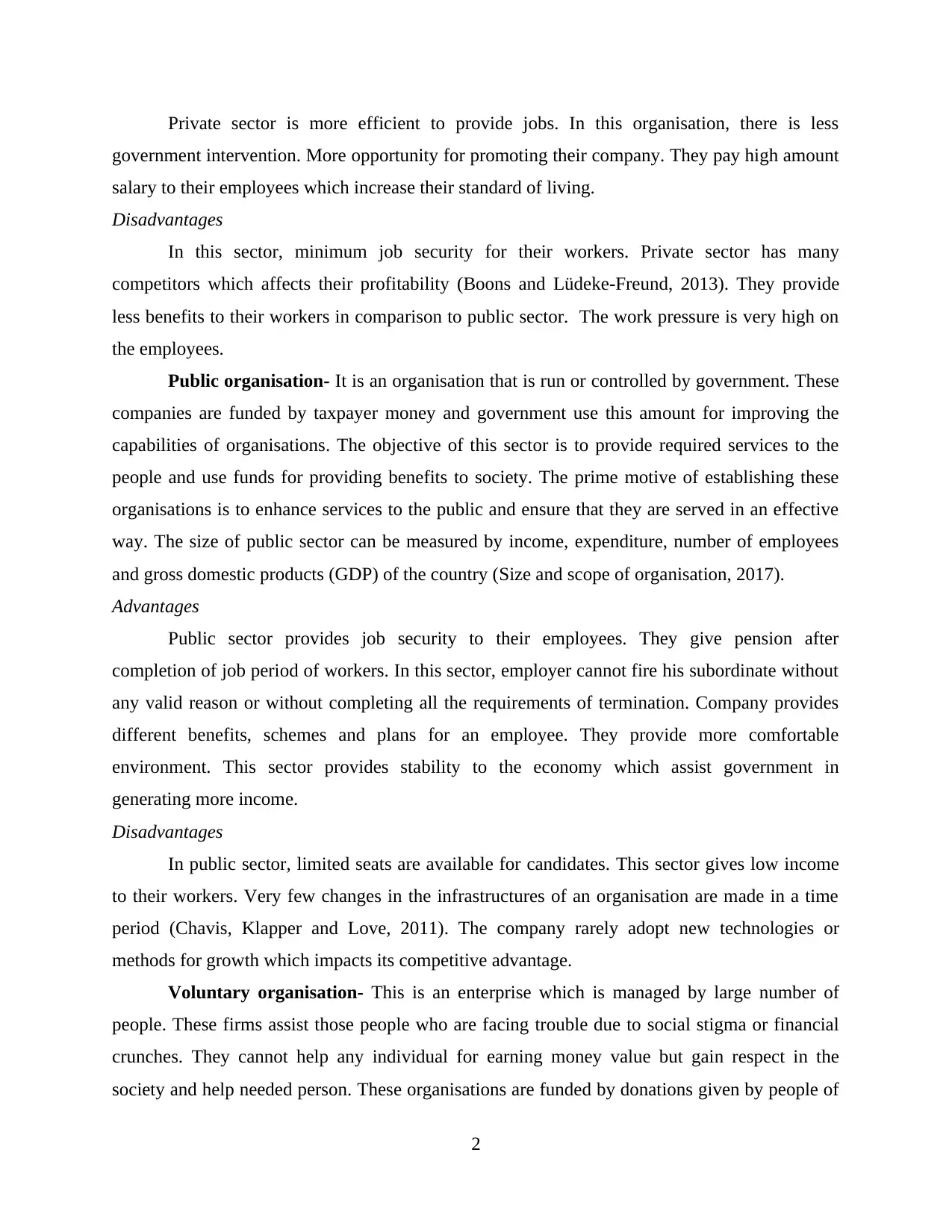
Private sector is more efficient to provide jobs. In this organisation, there is less
government intervention. More opportunity for promoting their company. They pay high amount
salary to their employees which increase their standard of living.
Disadvantages
In this sector, minimum job security for their workers. Private sector has many
competitors which affects their profitability (Boons and Lüdeke-Freund, 2013). They provide
less benefits to their workers in comparison to public sector. The work pressure is very high on
the employees.
Public organisation- It is an organisation that is run or controlled by government. These
companies are funded by taxpayer money and government use this amount for improving the
capabilities of organisations. The objective of this sector is to provide required services to the
people and use funds for providing benefits to society. The prime motive of establishing these
organisations is to enhance services to the public and ensure that they are served in an effective
way. The size of public sector can be measured by income, expenditure, number of employees
and gross domestic products (GDP) of the country (Size and scope of organisation, 2017).
Advantages
Public sector provides job security to their employees. They give pension after
completion of job period of workers. In this sector, employer cannot fire his subordinate without
any valid reason or without completing all the requirements of termination. Company provides
different benefits, schemes and plans for an employee. They provide more comfortable
environment. This sector provides stability to the economy which assist government in
generating more income.
Disadvantages
In public sector, limited seats are available for candidates. This sector gives low income
to their workers. Very few changes in the infrastructures of an organisation are made in a time
period (Chavis, Klapper and Love, 2011). The company rarely adopt new technologies or
methods for growth which impacts its competitive advantage.
Voluntary organisation- This is an enterprise which is managed by large number of
people. These firms assist those people who are facing trouble due to social stigma or financial
crunches. They cannot help any individual for earning money value but gain respect in the
society and help needed person. These organisations are funded by donations given by people of
2
government intervention. More opportunity for promoting their company. They pay high amount
salary to their employees which increase their standard of living.
Disadvantages
In this sector, minimum job security for their workers. Private sector has many
competitors which affects their profitability (Boons and Lüdeke-Freund, 2013). They provide
less benefits to their workers in comparison to public sector. The work pressure is very high on
the employees.
Public organisation- It is an organisation that is run or controlled by government. These
companies are funded by taxpayer money and government use this amount for improving the
capabilities of organisations. The objective of this sector is to provide required services to the
people and use funds for providing benefits to society. The prime motive of establishing these
organisations is to enhance services to the public and ensure that they are served in an effective
way. The size of public sector can be measured by income, expenditure, number of employees
and gross domestic products (GDP) of the country (Size and scope of organisation, 2017).
Advantages
Public sector provides job security to their employees. They give pension after
completion of job period of workers. In this sector, employer cannot fire his subordinate without
any valid reason or without completing all the requirements of termination. Company provides
different benefits, schemes and plans for an employee. They provide more comfortable
environment. This sector provides stability to the economy which assist government in
generating more income.
Disadvantages
In public sector, limited seats are available for candidates. This sector gives low income
to their workers. Very few changes in the infrastructures of an organisation are made in a time
period (Chavis, Klapper and Love, 2011). The company rarely adopt new technologies or
methods for growth which impacts its competitive advantage.
Voluntary organisation- This is an enterprise which is managed by large number of
people. These firms assist those people who are facing trouble due to social stigma or financial
crunches. They cannot help any individual for earning money value but gain respect in the
society and help needed person. These organisations are funded by donations given by people of
2
Paraphrase This Document
Need a fresh take? Get an instant paraphrase of this document with our AI Paraphraser
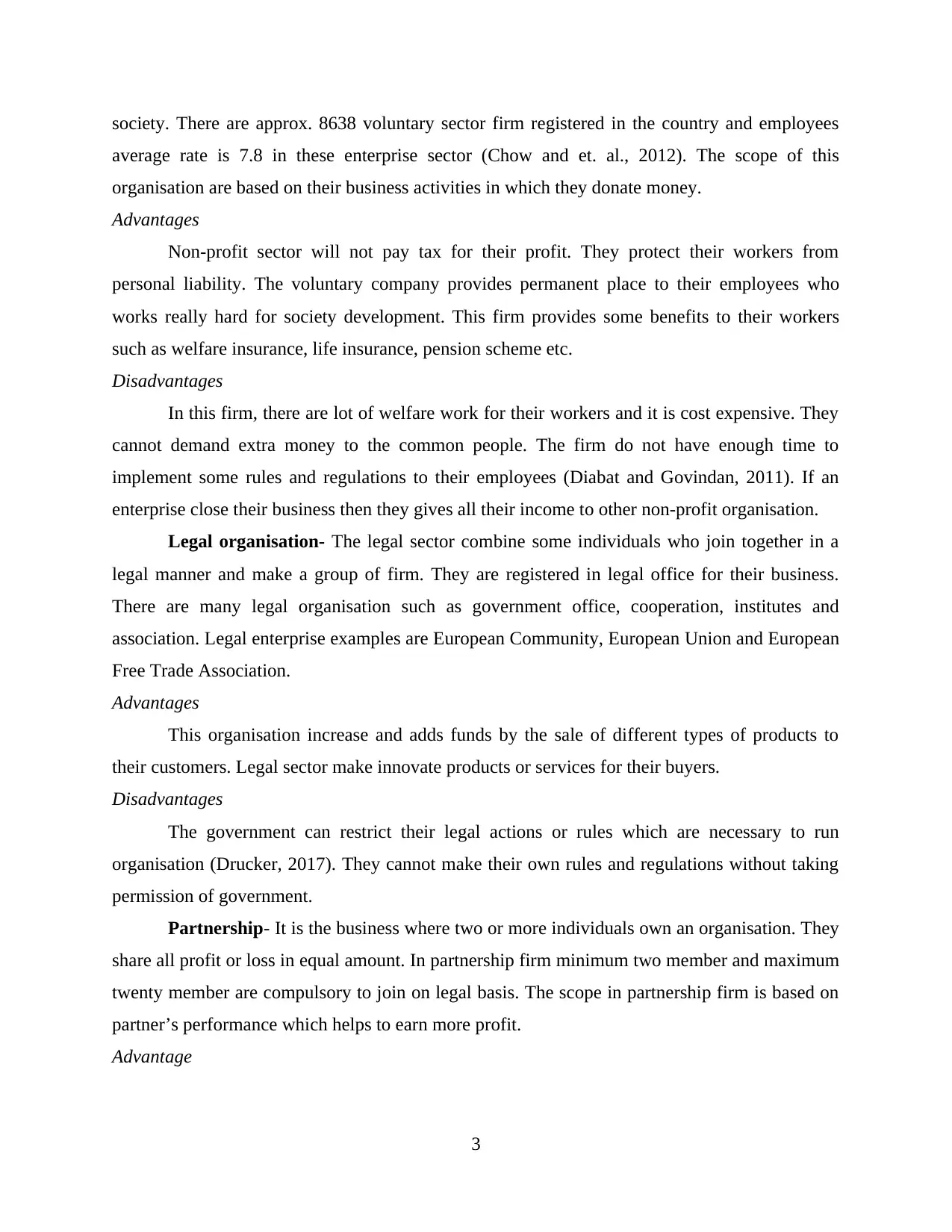
society. There are approx. 8638 voluntary sector firm registered in the country and employees
average rate is 7.8 in these enterprise sector (Chow and et. al., 2012). The scope of this
organisation are based on their business activities in which they donate money.
Advantages
Non-profit sector will not pay tax for their profit. They protect their workers from
personal liability. The voluntary company provides permanent place to their employees who
works really hard for society development. This firm provides some benefits to their workers
such as welfare insurance, life insurance, pension scheme etc.
Disadvantages
In this firm, there are lot of welfare work for their workers and it is cost expensive. They
cannot demand extra money to the common people. The firm do not have enough time to
implement some rules and regulations to their employees (Diabat and Govindan, 2011). If an
enterprise close their business then they gives all their income to other non-profit organisation.
Legal organisation- The legal sector combine some individuals who join together in a
legal manner and make a group of firm. They are registered in legal office for their business.
There are many legal organisation such as government office, cooperation, institutes and
association. Legal enterprise examples are European Community, European Union and European
Free Trade Association.
Advantages
This organisation increase and adds funds by the sale of different types of products to
their customers. Legal sector make innovate products or services for their buyers.
Disadvantages
The government can restrict their legal actions or rules which are necessary to run
organisation (Drucker, 2017). They cannot make their own rules and regulations without taking
permission of government.
Partnership- It is the business where two or more individuals own an organisation. They
share all profit or loss in equal amount. In partnership firm minimum two member and maximum
twenty member are compulsory to join on legal basis. The scope in partnership firm is based on
partner’s performance which helps to earn more profit.
Advantage
3
average rate is 7.8 in these enterprise sector (Chow and et. al., 2012). The scope of this
organisation are based on their business activities in which they donate money.
Advantages
Non-profit sector will not pay tax for their profit. They protect their workers from
personal liability. The voluntary company provides permanent place to their employees who
works really hard for society development. This firm provides some benefits to their workers
such as welfare insurance, life insurance, pension scheme etc.
Disadvantages
In this firm, there are lot of welfare work for their workers and it is cost expensive. They
cannot demand extra money to the common people. The firm do not have enough time to
implement some rules and regulations to their employees (Diabat and Govindan, 2011). If an
enterprise close their business then they gives all their income to other non-profit organisation.
Legal organisation- The legal sector combine some individuals who join together in a
legal manner and make a group of firm. They are registered in legal office for their business.
There are many legal organisation such as government office, cooperation, institutes and
association. Legal enterprise examples are European Community, European Union and European
Free Trade Association.
Advantages
This organisation increase and adds funds by the sale of different types of products to
their customers. Legal sector make innovate products or services for their buyers.
Disadvantages
The government can restrict their legal actions or rules which are necessary to run
organisation (Drucker, 2017). They cannot make their own rules and regulations without taking
permission of government.
Partnership- It is the business where two or more individuals own an organisation. They
share all profit or loss in equal amount. In partnership firm minimum two member and maximum
twenty member are compulsory to join on legal basis. The scope in partnership firm is based on
partner’s performance which helps to earn more profit.
Advantage
3
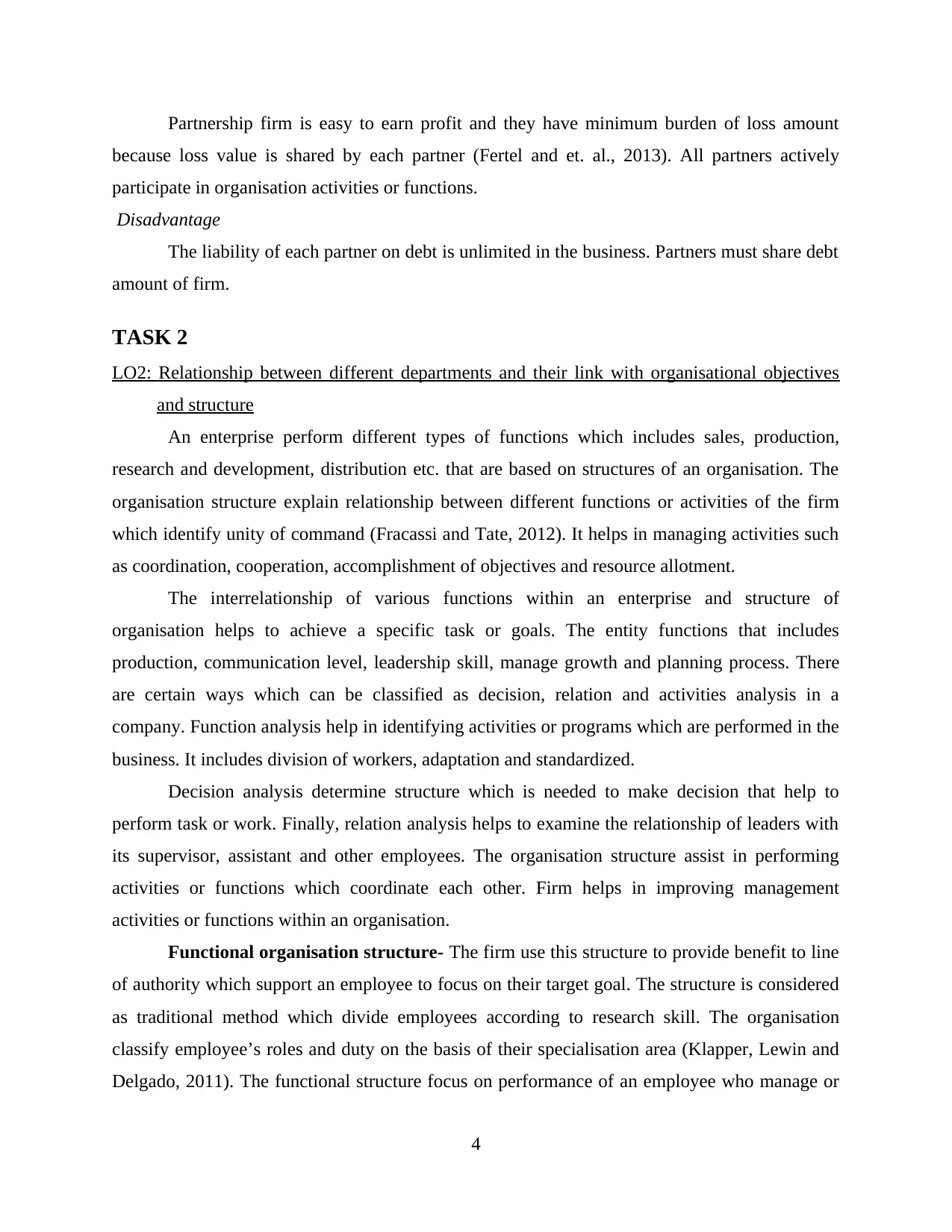
Partnership firm is easy to earn profit and they have minimum burden of loss amount
because loss value is shared by each partner (Fertel and et. al., 2013). All partners actively
participate in organisation activities or functions.
Disadvantage
The liability of each partner on debt is unlimited in the business. Partners must share debt
amount of firm.
TASK 2
LO2: Relationship between different departments and their link with organisational objectives
and structure
An enterprise perform different types of functions which includes sales, production,
research and development, distribution etc. that are based on structures of an organisation. The
organisation structure explain relationship between different functions or activities of the firm
which identify unity of command (Fracassi and Tate, 2012). It helps in managing activities such
as coordination, cooperation, accomplishment of objectives and resource allotment.
The interrelationship of various functions within an enterprise and structure of
organisation helps to achieve a specific task or goals. The entity functions that includes
production, communication level, leadership skill, manage growth and planning process. There
are certain ways which can be classified as decision, relation and activities analysis in a
company. Function analysis help in identifying activities or programs which are performed in the
business. It includes division of workers, adaptation and standardized.
Decision analysis determine structure which is needed to make decision that help to
perform task or work. Finally, relation analysis helps to examine the relationship of leaders with
its supervisor, assistant and other employees. The organisation structure assist in performing
activities or functions which coordinate each other. Firm helps in improving management
activities or functions within an organisation.
Functional organisation structure- The firm use this structure to provide benefit to line
of authority which support an employee to focus on their target goal. The structure is considered
as traditional method which divide employees according to research skill. The organisation
classify employee’s roles and duty on the basis of their specialisation area (Klapper, Lewin and
Delgado, 2011). The functional structure focus on performance of an employee who manage or
4
because loss value is shared by each partner (Fertel and et. al., 2013). All partners actively
participate in organisation activities or functions.
Disadvantage
The liability of each partner on debt is unlimited in the business. Partners must share debt
amount of firm.
TASK 2
LO2: Relationship between different departments and their link with organisational objectives
and structure
An enterprise perform different types of functions which includes sales, production,
research and development, distribution etc. that are based on structures of an organisation. The
organisation structure explain relationship between different functions or activities of the firm
which identify unity of command (Fracassi and Tate, 2012). It helps in managing activities such
as coordination, cooperation, accomplishment of objectives and resource allotment.
The interrelationship of various functions within an enterprise and structure of
organisation helps to achieve a specific task or goals. The entity functions that includes
production, communication level, leadership skill, manage growth and planning process. There
are certain ways which can be classified as decision, relation and activities analysis in a
company. Function analysis help in identifying activities or programs which are performed in the
business. It includes division of workers, adaptation and standardized.
Decision analysis determine structure which is needed to make decision that help to
perform task or work. Finally, relation analysis helps to examine the relationship of leaders with
its supervisor, assistant and other employees. The organisation structure assist in performing
activities or functions which coordinate each other. Firm helps in improving management
activities or functions within an organisation.
Functional organisation structure- The firm use this structure to provide benefit to line
of authority which support an employee to focus on their target goal. The structure is considered
as traditional method which divide employees according to research skill. The organisation
classify employee’s roles and duty on the basis of their specialisation area (Klapper, Lewin and
Delgado, 2011). The functional structure focus on performance of an employee who manage or
4
⊘ This is a preview!⊘
Do you want full access?
Subscribe today to unlock all pages.

Trusted by 1+ million students worldwide
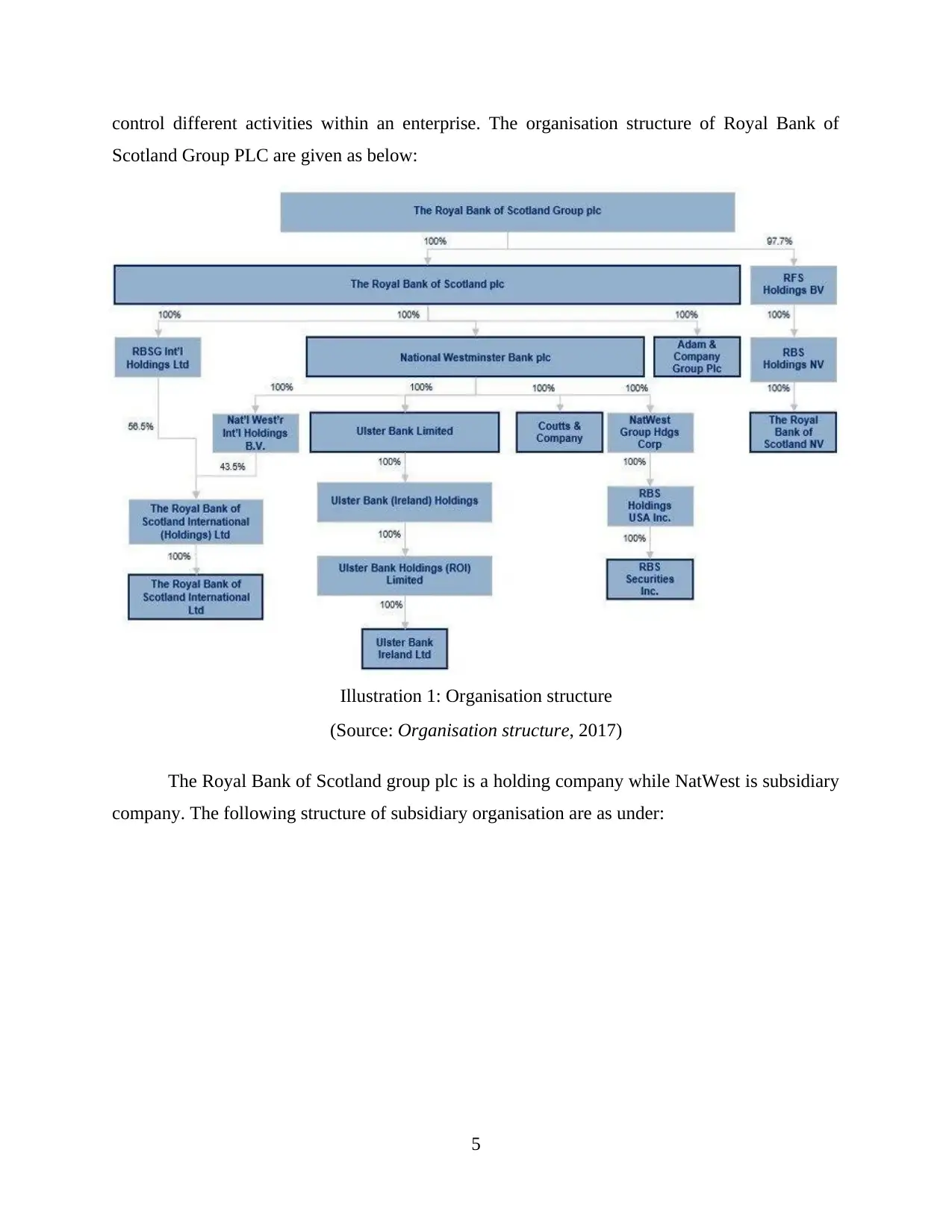
control different activities within an enterprise. The organisation structure of Royal Bank of
Scotland Group PLC are given as below:
(Source: Organisation structure, 2017)
The Royal Bank of Scotland group plc is a holding company while NatWest is subsidiary
company. The following structure of subsidiary organisation are as under:
5
Illustration 1: Organisation structure
Scotland Group PLC are given as below:
(Source: Organisation structure, 2017)
The Royal Bank of Scotland group plc is a holding company while NatWest is subsidiary
company. The following structure of subsidiary organisation are as under:
5
Illustration 1: Organisation structure
Paraphrase This Document
Need a fresh take? Get an instant paraphrase of this document with our AI Paraphraser
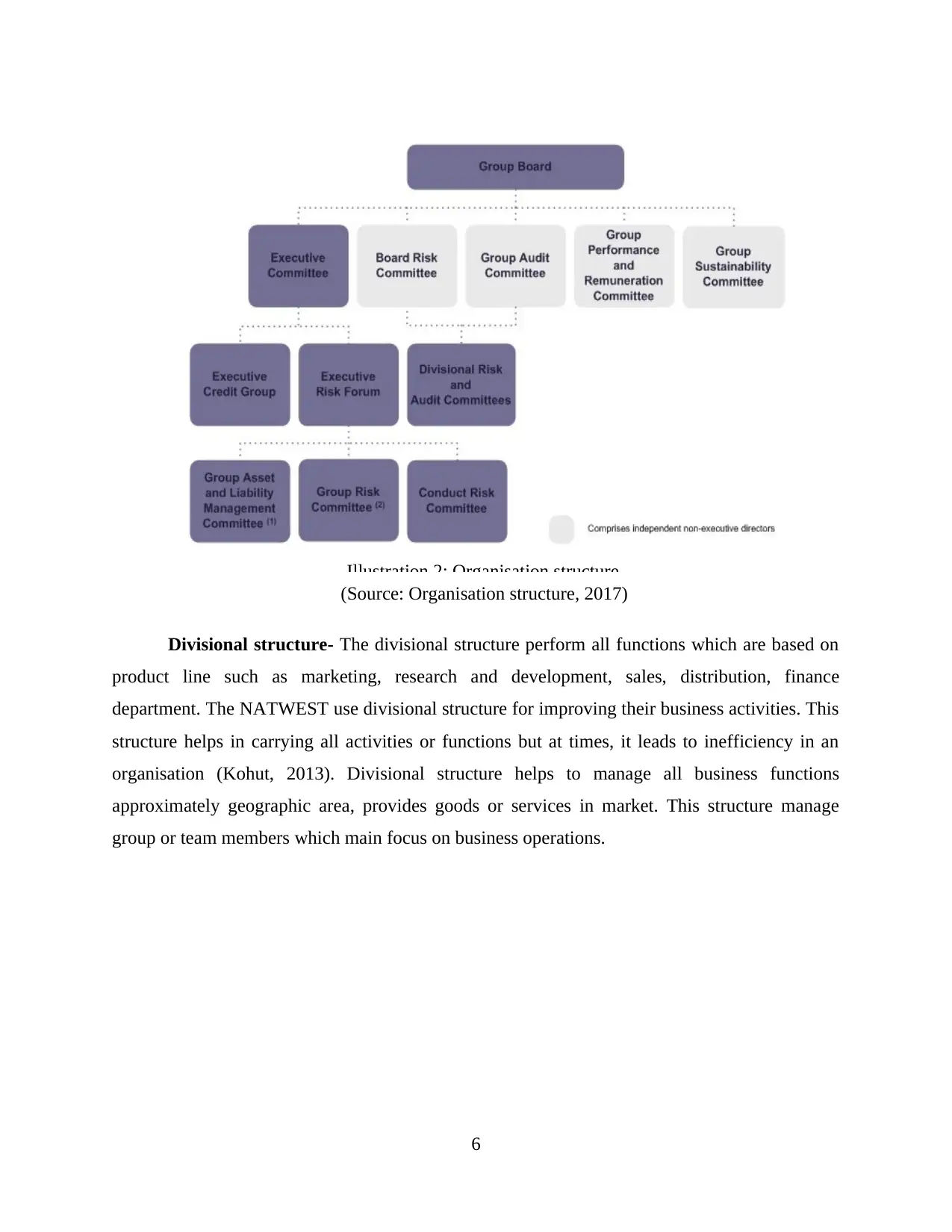
(Source: Organisation structure, 2017)
Divisional structure- The divisional structure perform all functions which are based on
product line such as marketing, research and development, sales, distribution, finance
department. The NATWEST use divisional structure for improving their business activities. This
structure helps in carrying all activities or functions but at times, it leads to inefficiency in an
organisation (Kohut, 2013). Divisional structure helps to manage all business functions
approximately geographic area, provides goods or services in market. This structure manage
group or team members which main focus on business operations.
6
Illustration 2: Organisation structure
Divisional structure- The divisional structure perform all functions which are based on
product line such as marketing, research and development, sales, distribution, finance
department. The NATWEST use divisional structure for improving their business activities. This
structure helps in carrying all activities or functions but at times, it leads to inefficiency in an
organisation (Kohut, 2013). Divisional structure helps to manage all business functions
approximately geographic area, provides goods or services in market. This structure manage
group or team members which main focus on business operations.
6
Illustration 2: Organisation structure
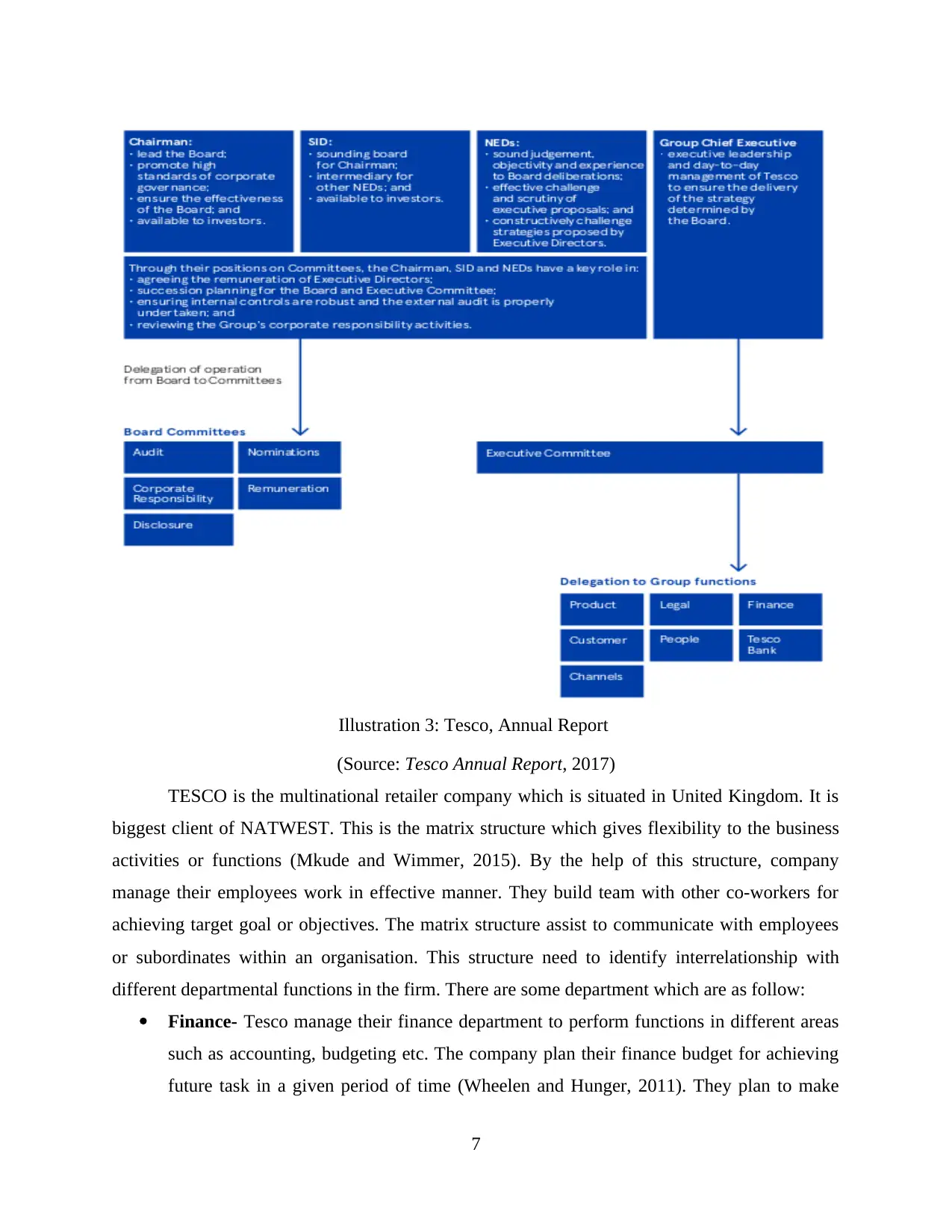
(Source: Tesco Annual Report, 2017)
TESCO is the multinational retailer company which is situated in United Kingdom. It is
biggest client of NATWEST. This is the matrix structure which gives flexibility to the business
activities or functions (Mkude and Wimmer, 2015). By the help of this structure, company
manage their employees work in effective manner. They build team with other co-workers for
achieving target goal or objectives. The matrix structure assist to communicate with employees
or subordinates within an organisation. This structure need to identify interrelationship with
different departmental functions in the firm. There are some department which are as follow:
Finance- Tesco manage their finance department to perform functions in different areas
such as accounting, budgeting etc. The company plan their finance budget for achieving
future task in a given period of time (Wheelen and Hunger, 2011). They plan to make
7
Illustration 3: Tesco, Annual Report
TESCO is the multinational retailer company which is situated in United Kingdom. It is
biggest client of NATWEST. This is the matrix structure which gives flexibility to the business
activities or functions (Mkude and Wimmer, 2015). By the help of this structure, company
manage their employees work in effective manner. They build team with other co-workers for
achieving target goal or objectives. The matrix structure assist to communicate with employees
or subordinates within an organisation. This structure need to identify interrelationship with
different departmental functions in the firm. There are some department which are as follow:
Finance- Tesco manage their finance department to perform functions in different areas
such as accounting, budgeting etc. The company plan their finance budget for achieving
future task in a given period of time (Wheelen and Hunger, 2011). They plan to make
7
Illustration 3: Tesco, Annual Report
⊘ This is a preview!⊘
Do you want full access?
Subscribe today to unlock all pages.

Trusted by 1+ million students worldwide
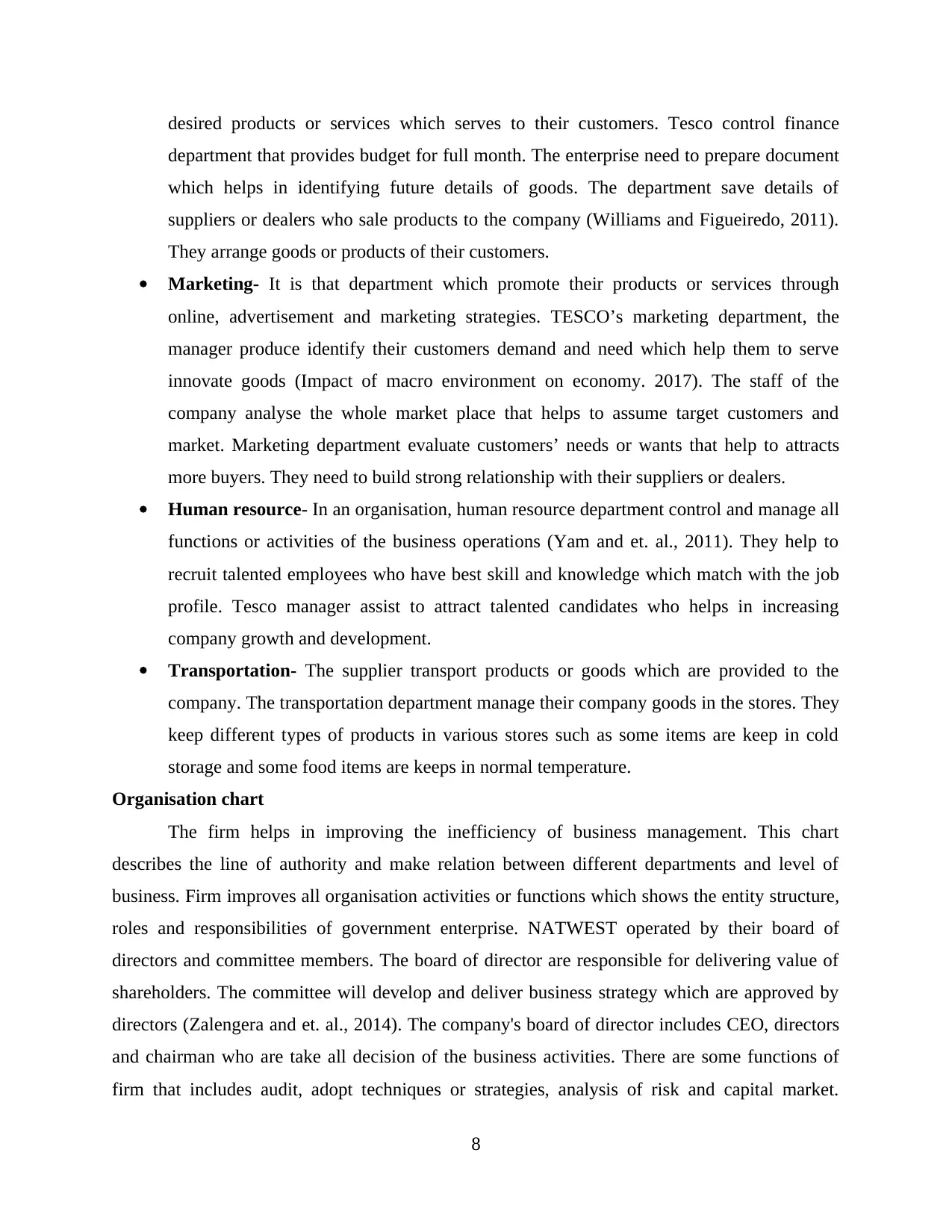
desired products or services which serves to their customers. Tesco control finance
department that provides budget for full month. The enterprise need to prepare document
which helps in identifying future details of goods. The department save details of
suppliers or dealers who sale products to the company (Williams and Figueiredo, 2011).
They arrange goods or products of their customers.
Marketing- It is that department which promote their products or services through
online, advertisement and marketing strategies. TESCO’s marketing department, the
manager produce identify their customers demand and need which help them to serve
innovate goods (Impact of macro environment on economy. 2017). The staff of the
company analyse the whole market place that helps to assume target customers and
market. Marketing department evaluate customers’ needs or wants that help to attracts
more buyers. They need to build strong relationship with their suppliers or dealers.
Human resource- In an organisation, human resource department control and manage all
functions or activities of the business operations (Yam and et. al., 2011). They help to
recruit talented employees who have best skill and knowledge which match with the job
profile. Tesco manager assist to attract talented candidates who helps in increasing
company growth and development.
Transportation- The supplier transport products or goods which are provided to the
company. The transportation department manage their company goods in the stores. They
keep different types of products in various stores such as some items are keep in cold
storage and some food items are keeps in normal temperature.
Organisation chart
The firm helps in improving the inefficiency of business management. This chart
describes the line of authority and make relation between different departments and level of
business. Firm improves all organisation activities or functions which shows the entity structure,
roles and responsibilities of government enterprise. NATWEST operated by their board of
directors and committee members. The board of director are responsible for delivering value of
shareholders. The committee will develop and deliver business strategy which are approved by
directors (Zalengera and et. al., 2014). The company's board of director includes CEO, directors
and chairman who are take all decision of the business activities. There are some functions of
firm that includes audit, adopt techniques or strategies, analysis of risk and capital market.
8
department that provides budget for full month. The enterprise need to prepare document
which helps in identifying future details of goods. The department save details of
suppliers or dealers who sale products to the company (Williams and Figueiredo, 2011).
They arrange goods or products of their customers.
Marketing- It is that department which promote their products or services through
online, advertisement and marketing strategies. TESCO’s marketing department, the
manager produce identify their customers demand and need which help them to serve
innovate goods (Impact of macro environment on economy. 2017). The staff of the
company analyse the whole market place that helps to assume target customers and
market. Marketing department evaluate customers’ needs or wants that help to attracts
more buyers. They need to build strong relationship with their suppliers or dealers.
Human resource- In an organisation, human resource department control and manage all
functions or activities of the business operations (Yam and et. al., 2011). They help to
recruit talented employees who have best skill and knowledge which match with the job
profile. Tesco manager assist to attract talented candidates who helps in increasing
company growth and development.
Transportation- The supplier transport products or goods which are provided to the
company. The transportation department manage their company goods in the stores. They
keep different types of products in various stores such as some items are keep in cold
storage and some food items are keeps in normal temperature.
Organisation chart
The firm helps in improving the inefficiency of business management. This chart
describes the line of authority and make relation between different departments and level of
business. Firm improves all organisation activities or functions which shows the entity structure,
roles and responsibilities of government enterprise. NATWEST operated by their board of
directors and committee members. The board of director are responsible for delivering value of
shareholders. The committee will develop and deliver business strategy which are approved by
directors (Zalengera and et. al., 2014). The company's board of director includes CEO, directors
and chairman who are take all decision of the business activities. There are some functions of
firm that includes audit, adopt techniques or strategies, analysis of risk and capital market.
8
Paraphrase This Document
Need a fresh take? Get an instant paraphrase of this document with our AI Paraphraser
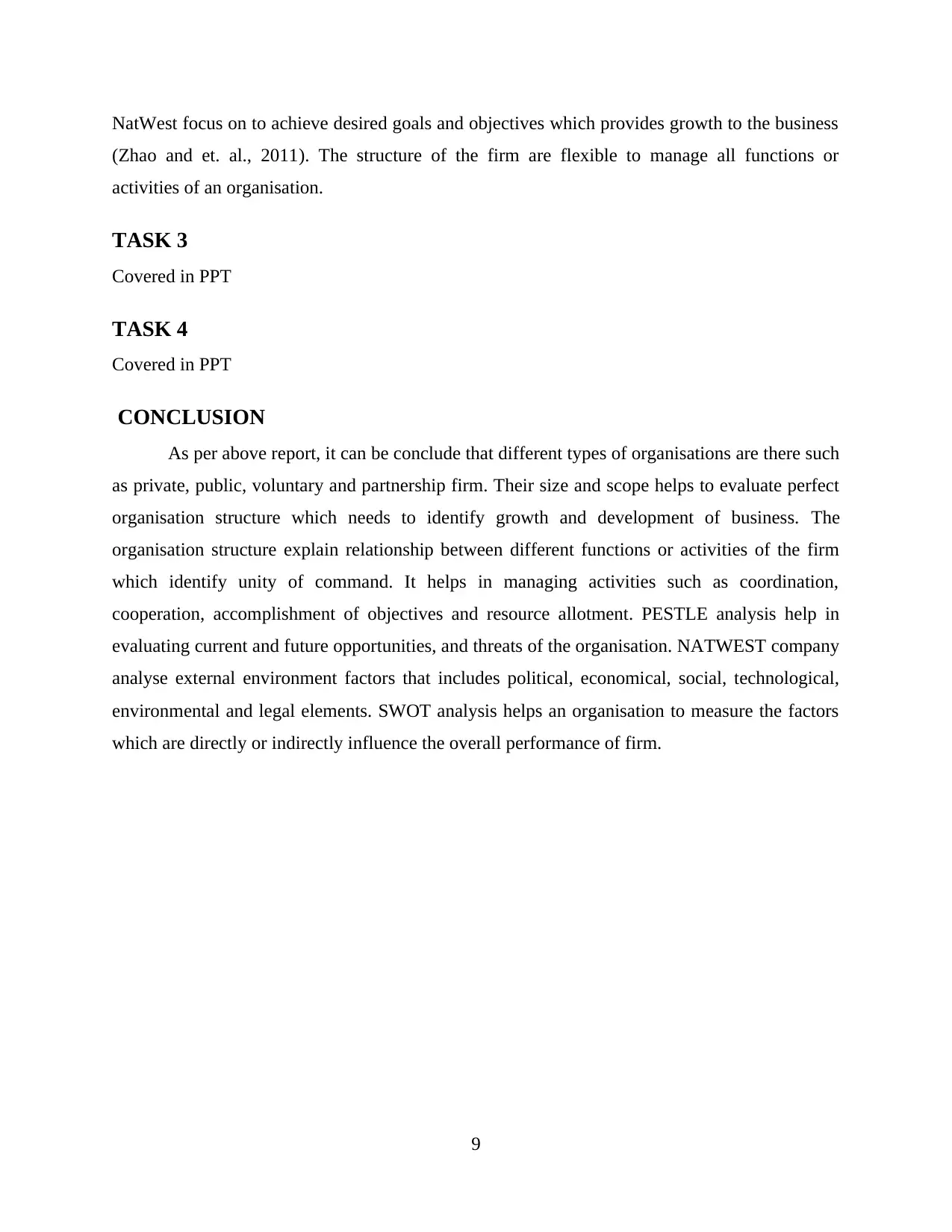
NatWest focus on to achieve desired goals and objectives which provides growth to the business
(Zhao and et. al., 2011). The structure of the firm are flexible to manage all functions or
activities of an organisation.
TASK 3
Covered in PPT
TASK 4
Covered in PPT
CONCLUSION
As per above report, it can be conclude that different types of organisations are there such
as private, public, voluntary and partnership firm. Their size and scope helps to evaluate perfect
organisation structure which needs to identify growth and development of business. The
organisation structure explain relationship between different functions or activities of the firm
which identify unity of command. It helps in managing activities such as coordination,
cooperation, accomplishment of objectives and resource allotment. PESTLE analysis help in
evaluating current and future opportunities, and threats of the organisation. NATWEST company
analyse external environment factors that includes political, economical, social, technological,
environmental and legal elements. SWOT analysis helps an organisation to measure the factors
which are directly or indirectly influence the overall performance of firm.
9
(Zhao and et. al., 2011). The structure of the firm are flexible to manage all functions or
activities of an organisation.
TASK 3
Covered in PPT
TASK 4
Covered in PPT
CONCLUSION
As per above report, it can be conclude that different types of organisations are there such
as private, public, voluntary and partnership firm. Their size and scope helps to evaluate perfect
organisation structure which needs to identify growth and development of business. The
organisation structure explain relationship between different functions or activities of the firm
which identify unity of command. It helps in managing activities such as coordination,
cooperation, accomplishment of objectives and resource allotment. PESTLE analysis help in
evaluating current and future opportunities, and threats of the organisation. NATWEST company
analyse external environment factors that includes political, economical, social, technological,
environmental and legal elements. SWOT analysis helps an organisation to measure the factors
which are directly or indirectly influence the overall performance of firm.
9
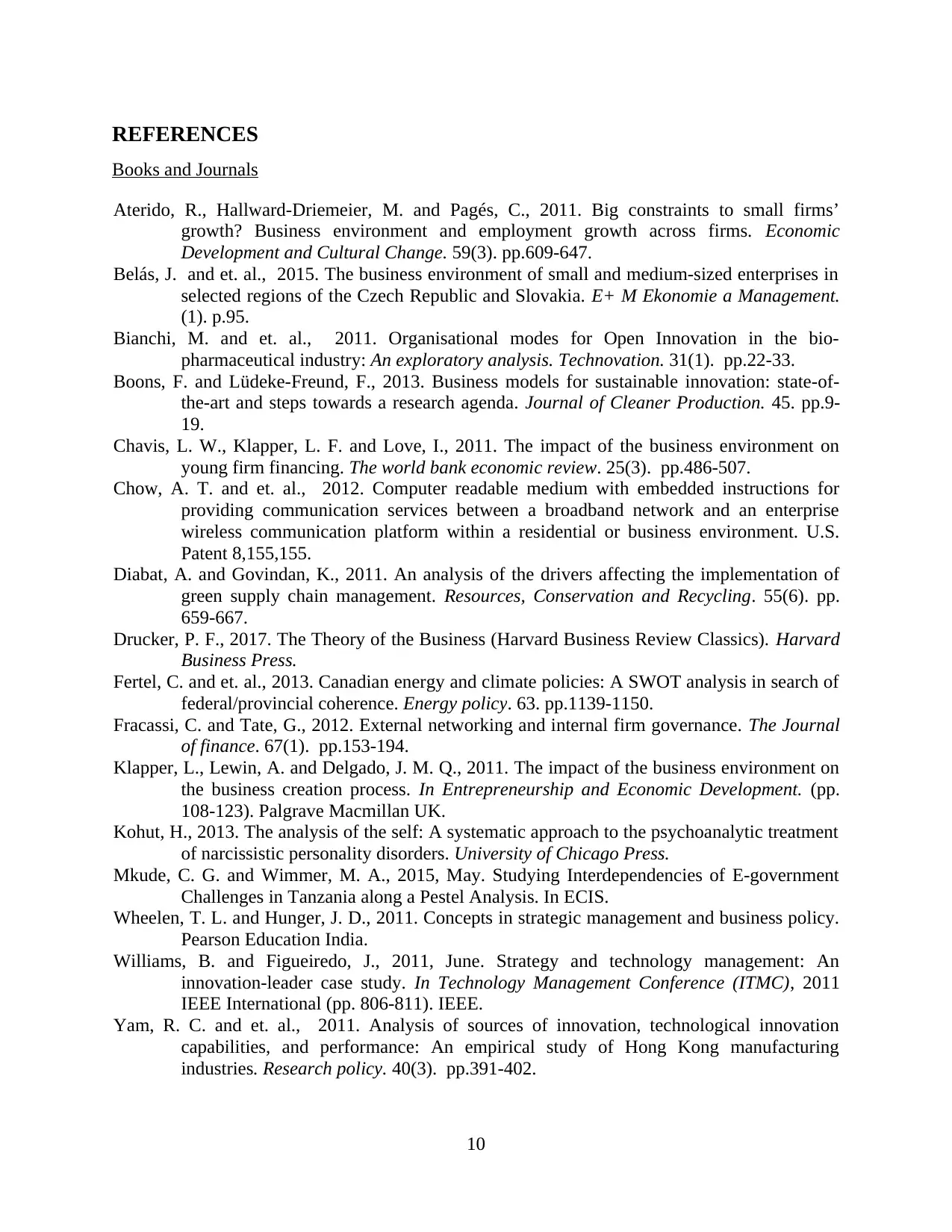
REFERENCES
Books and Journals
Aterido, R., Hallward-Driemeier, M. and Pagés, C., 2011. Big constraints to small firms’
growth? Business environment and employment growth across firms. Economic
Development and Cultural Change. 59(3). pp.609-647.
Belás, J. and et. al., 2015. The business environment of small and medium-sized enterprises in
selected regions of the Czech Republic and Slovakia. E+ M Ekonomie a Management.
(1). p.95.
Bianchi, M. and et. al., 2011. Organisational modes for Open Innovation in the bio-
pharmaceutical industry: An exploratory analysis. Technovation. 31(1). pp.22-33.
Boons, F. and Lüdeke-Freund, F., 2013. Business models for sustainable innovation: state-of-
the-art and steps towards a research agenda. Journal of Cleaner Production. 45. pp.9-
19.
Chavis, L. W., Klapper, L. F. and Love, I., 2011. The impact of the business environment on
young firm financing. The world bank economic review. 25(3). pp.486-507.
Chow, A. T. and et. al., 2012. Computer readable medium with embedded instructions for
providing communication services between a broadband network and an enterprise
wireless communication platform within a residential or business environment. U.S.
Patent 8,155,155.
Diabat, A. and Govindan, K., 2011. An analysis of the drivers affecting the implementation of
green supply chain management. Resources, Conservation and Recycling. 55(6). pp.
659-667.
Drucker, P. F., 2017. The Theory of the Business (Harvard Business Review Classics). Harvard
Business Press.
Fertel, C. and et. al., 2013. Canadian energy and climate policies: A SWOT analysis in search of
federal/provincial coherence. Energy policy. 63. pp.1139-1150.
Fracassi, C. and Tate, G., 2012. External networking and internal firm governance. The Journal
of finance. 67(1). pp.153-194.
Klapper, L., Lewin, A. and Delgado, J. M. Q., 2011. The impact of the business environment on
the business creation process. In Entrepreneurship and Economic Development. (pp.
108-123). Palgrave Macmillan UK.
Kohut, H., 2013. The analysis of the self: A systematic approach to the psychoanalytic treatment
of narcissistic personality disorders. University of Chicago Press.
Mkude, C. G. and Wimmer, M. A., 2015, May. Studying Interdependencies of E-government
Challenges in Tanzania along a Pestel Analysis. In ECIS.
Wheelen, T. L. and Hunger, J. D., 2011. Concepts in strategic management and business policy.
Pearson Education India.
Williams, B. and Figueiredo, J., 2011, June. Strategy and technology management: An
innovation-leader case study. In Technology Management Conference (ITMC), 2011
IEEE International (pp. 806-811). IEEE.
Yam, R. C. and et. al., 2011. Analysis of sources of innovation, technological innovation
capabilities, and performance: An empirical study of Hong Kong manufacturing
industries. Research policy. 40(3). pp.391-402.
10
Books and Journals
Aterido, R., Hallward-Driemeier, M. and Pagés, C., 2011. Big constraints to small firms’
growth? Business environment and employment growth across firms. Economic
Development and Cultural Change. 59(3). pp.609-647.
Belás, J. and et. al., 2015. The business environment of small and medium-sized enterprises in
selected regions of the Czech Republic and Slovakia. E+ M Ekonomie a Management.
(1). p.95.
Bianchi, M. and et. al., 2011. Organisational modes for Open Innovation in the bio-
pharmaceutical industry: An exploratory analysis. Technovation. 31(1). pp.22-33.
Boons, F. and Lüdeke-Freund, F., 2013. Business models for sustainable innovation: state-of-
the-art and steps towards a research agenda. Journal of Cleaner Production. 45. pp.9-
19.
Chavis, L. W., Klapper, L. F. and Love, I., 2011. The impact of the business environment on
young firm financing. The world bank economic review. 25(3). pp.486-507.
Chow, A. T. and et. al., 2012. Computer readable medium with embedded instructions for
providing communication services between a broadband network and an enterprise
wireless communication platform within a residential or business environment. U.S.
Patent 8,155,155.
Diabat, A. and Govindan, K., 2011. An analysis of the drivers affecting the implementation of
green supply chain management. Resources, Conservation and Recycling. 55(6). pp.
659-667.
Drucker, P. F., 2017. The Theory of the Business (Harvard Business Review Classics). Harvard
Business Press.
Fertel, C. and et. al., 2013. Canadian energy and climate policies: A SWOT analysis in search of
federal/provincial coherence. Energy policy. 63. pp.1139-1150.
Fracassi, C. and Tate, G., 2012. External networking and internal firm governance. The Journal
of finance. 67(1). pp.153-194.
Klapper, L., Lewin, A. and Delgado, J. M. Q., 2011. The impact of the business environment on
the business creation process. In Entrepreneurship and Economic Development. (pp.
108-123). Palgrave Macmillan UK.
Kohut, H., 2013. The analysis of the self: A systematic approach to the psychoanalytic treatment
of narcissistic personality disorders. University of Chicago Press.
Mkude, C. G. and Wimmer, M. A., 2015, May. Studying Interdependencies of E-government
Challenges in Tanzania along a Pestel Analysis. In ECIS.
Wheelen, T. L. and Hunger, J. D., 2011. Concepts in strategic management and business policy.
Pearson Education India.
Williams, B. and Figueiredo, J., 2011, June. Strategy and technology management: An
innovation-leader case study. In Technology Management Conference (ITMC), 2011
IEEE International (pp. 806-811). IEEE.
Yam, R. C. and et. al., 2011. Analysis of sources of innovation, technological innovation
capabilities, and performance: An empirical study of Hong Kong manufacturing
industries. Research policy. 40(3). pp.391-402.
10
⊘ This is a preview!⊘
Do you want full access?
Subscribe today to unlock all pages.

Trusted by 1+ million students worldwide
1 out of 13
Related Documents
Your All-in-One AI-Powered Toolkit for Academic Success.
+13062052269
info@desklib.com
Available 24*7 on WhatsApp / Email
![[object Object]](/_next/static/media/star-bottom.7253800d.svg)
Unlock your academic potential
Copyright © 2020–2025 A2Z Services. All Rights Reserved. Developed and managed by ZUCOL.





